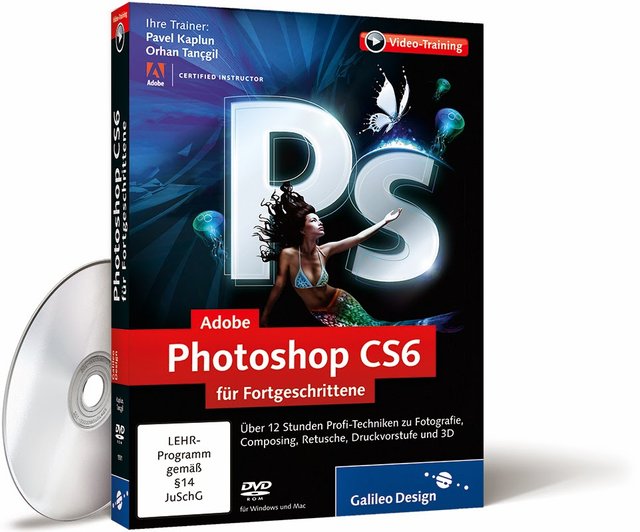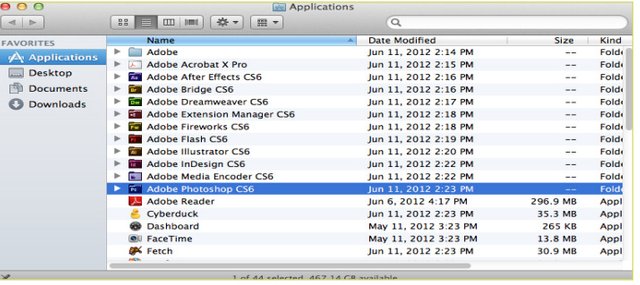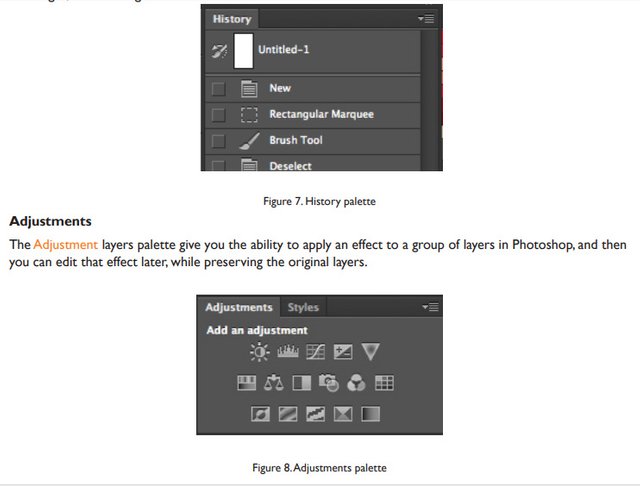Adobe Photoshop CS6/CC Full Tutorial
GETTING STARTED

Adobe Photoshop CS6/CC is a popular image editing software that provides a work environment consistent with Adobe Illustrator, Adobe InDesign, Adobe Photoshop and other products in the Adobe Creative Suite. This tutorial is an introduction to using Adobe Photoshop. Here you will learn how to get started, how to use the interface, and how to modify images with basic editing skills.

- Begin by opening Adobe Photoshop CS6/CC.
On a PC, click Start > Programs > Adobe > Photoshop CS6/CC, or click on the shortcut on the desktop. On a Mac, click Go > Applications > Adobe Photoshop CS6/CC > Photoshop CS6/CC shown in Figure 1, or click the icon in the Dock.
Setting up the document
Setting up your document correctly from the start will make your job much easier as you work through your project. This will require some advanced planning. For example, if your final output will be a brochure, you may need to set up your document to be horizontal and double-sided.
To create a new document, click File > New. This will open the Document Setup dialog box (Figure 2). Here you will be able to name your file, set up the correct page size and orientation for your document.
Options include, but are not limited to:

Page Size and Orientation
Change the page size by typing in new values for width and height. Page size represents the final size you want after bleeds or trimming other marks outside the page. In the Preset dropdown menu you can find such common sizes as letter, legal, tabloid, etc. Typing in exact values for Height and Width gives you more control over the size and orientation of your page.
Resolution
Resolution is the number of pixels on a printed area of an image. The higher the resolution, the more
pixels there are on the page, the better the quality of the image. However, high resolution increases
the size of the file. The standard recommended resolution for printed images is 150-300, for Web
images it is 72.
Color Mode
Choose a color mode that will best fit your project. For example, when making a graphic for a web
site, choose RGB. When making an image for print choose CMYK.
Background Contents
Choose the background: white, color or transparent. When you have entered all of your document
settings, click Ok.
Opening an image from a disk
If the image you have is saved on a disk or to the computer, select File > Open, and then navigate to the disk drive/file where your image is saved. Choose the image file and click Open. At this point, you may want to save your image under a different name so that you can always have the original to fall back on in case of a mistake.
To save your file, select File > Save As and type in the new name of the file in the dialogue box.
Interface Layout

Menu Bar
If you look at the top of the screen you will see the Menu bar (Figure 3), which contains all the main
functions of Photoshop, such as File, Edit, Image, Layer, Select, Filter, Analysis, 3D, View, Window, and
Help.
Toolbar
Most of the major tools are located in the Toolbar for easy access.
The Image
The image will appear in its own window once you open a file.
Image Name
The name of any image that you open will be at the top of the image window as shown above.
Palettes
Palettes contain functions that help you monitor and modify images. By default, palettes are stacked
together in groups. These are the palettes that are usually visible: Color, Adjustments and Layers. If none of the palettes are visible, go to Window in the Menu bar and choose the palettes you need.
Palettes
Below is the description of the most commonly used palettes in Adobe Photoshop CS6/CC. Palettes used for more advanced image editing will be covered in the Adobe Photoshop CS6/CCTutorial - Intermediate.
Color, Swatches, Style
The Color palette (Figure 4) displays the current foreground and background colors and RGB values for these colors. You can use the sliders to change the foreground and background colors in different color modes. You can also choose a color from the spectrum of colors displayed in the color ramp at the bottom of the palette.


History
The History palette (Figure 7) stores and displays each action performed allowing you jump to any recent stage of the image alteration. The alterations should be created during the current working session. After saving or closing the document, the History palette clears all the contents. Each time you apply a change to an image, the new state of that image is added to the palette. It is important to know that once you click on any of the previous stages, all the changes that were made after it will be lost.

Layers
Layers let you organize your work into distinct levels that can be edited and viewed as individual units. Every Photoshop CS6/CC document contains at least one layer. Creating multiple layers lets you easily control how your artwork is printed, displayed, and edited. You will use the Layers palette (Figure 9) often while creating a document,
so it is crucial to understand what it does and how to use it.
A) Layer Visibility -The eye shows that the selected layer is visible. Click on or off to see or to hide a layer.
B) Layer Locking Options -Click the checkered square icon to lock Transparency, click the brush icon to lock the Image, click the arrow icon to lock the Position, and click the lock icon to lock all options.
C) Layer Blending Mode -Defines how the layer’s pixels blend with underlying pixels in the image. By choosing a particular blending mode from the drop-down menu you can create a variety of special effects.
D) Fill -By typing in a value or dragging the slider you can specify the transparency.
E) Opacity - By typing in a value or dragging the slider, you can specify the transparency of the entire layer.

F) Layer Lock -The icon shows when the layer is locked and disappears when it is unlocked. Double-click the icon to unlock the layer.
G) Layer Options Menu -Click the black triangle to display the following options: New Layer, Duplicate Layer, Delete Layer, Layer Properties, etc. Some of the options are presented as icons at the bottom of the Layers palette.
H) Link Layers – Can be used to link layers together.
I) Layer Styles -If a layer has a style, an “F” icon shows at the bottom of the Layers palette. Click the little black triangle to see style options.
J) Layer Mask -Allows you to hide certain parts of the layer, which can then be revealed by using the paintbrush and the white paint color to expose portions of the layer.
K) Layer Set -This option helps to organize images with multiple layers. Click the icon to create a folder for several layers.
L) Create New Fill or Adjustment Layer -Have the same opacity and blending mode options as image layers and can be rearranged, deleted, hidden and duplicated in the same manner as image layers. Click the icon and select an option to create a new fill or adjustment layer.
M) Create New Layer -Click this icon to create a new layer.
N) Delete Layer -To delete a layer, select a layer in the Layers palette and drag it to the trash can icon, or select a layer and click the icon.
** Toolbox**
If you used other Adobe products, such as Illustrator or InDesign, you should be familiar with the toolbox in Adobe Photoshop CS6 as it shares some of the tools from these applications. If you are a new user of Adobe products, you should keep in mind that you might not need to use all of the tools. In this tutorial, only the basic tools will be discussed in-depth. Some tools in the toolbar have additional “hidden” tools. These tools have small black triangles in the right-hand corner. To view the “hidden” tools, click and hold down on any tool that has a gray triangle in the corner (Figure 10).

Selection Tools

** Alteration Tools
**
